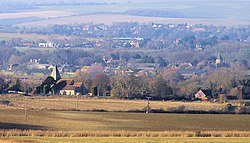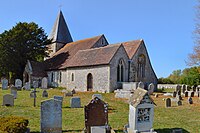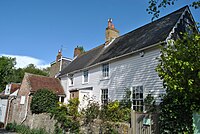Rodmell
| Rodmell | |
| Sussex | |
|---|---|
 Rodmell, Iford and Kingston from Itford Hill | |
| Location | |
| Grid reference: | TQ418059 |
| Location: | 50°50’9"N, 0°-0’48"E |
| Data | |
| Population: | 527 (2011) |
| Post town: | Lewes |
| Postcode: | BN7 |
| Dialling code: | 01273 |
| Local Government | |
| Council: | Lewes |
| Parliamentary constituency: |
Lewes |
| Website: | www.rodmell.net |
Rodmell is a small village in Sussex, by the west bank of the River Ouse, three miles south-west of Lewes, on the Lewes to Newhaven road and six and a half miles from Brighton. It is within the county's Holmstrow Hundred in the Rape of Lewes.
The village is served by Southease railway station, opened in 1906. The Greenwich Meridian passes just to the west of the village.
The name of the village has been variously spelled as Ramelle or Redmelle (11th century), Redmelde (12th century), Radmelde (13th century) and Radmill (18th century).[1] It most likely derives from Brittonic where Rhod denotes a wheel and Melin refers to a Mill, hence mill wheel. A less likely derivation is from Old English read *mylde, "[place with] red soil".[2]
The parish church, St. Peter's is early Norman. The font is believed to be Anglo-Saxon, predating the building itself.
Contents
St Peter's Church
St Peter's Church is the parish church and dates from the 12th century, though it contains a much earlier font, from the Anglo-Saxon period.
The church is a Grade I listed building and unlike many churches it has retained its original features. Consequently it is among the earliest surviving examples of Norman architecture in the country.[3]
History
Before the time of the Norman Conquest, the manor of Rodmell was held by Harold Godwinson.[1] At the time the Domesday Book was compiled, there was a church in Rodmell, which was granted to Lewes Priory by William de Warenne, 2nd Earl of Surrey.[1]
Like many of the county's southern parishes, Rodmell, is a long thin parish. From south-east to the north-west, it runs from Saltdean over the South Downs to the Lewes Brooks and as far as the River Ouse. To the north is the Iford parish and to the south is Southease.
More recently, Monk's House was the home of the author Virginia Woolf for twenty-one years until her death in 1941.
About the village
The South Downs Way crosses the scarp top. West from the track, on the Down between Highdole Hill and Fore Hill, there are many surviving marks from a busy Iron Age and Roman village. Unusually, the long and convoluted dry valley behind the scarp does not drain southwards to the sea, but easterly, then northerly to the Brooks and the Ouse.[4]
The area of the Lewes Brooks in the parish is designated a [Site of Special Scientific Interest, of biological importance and is part of the flood plain of the River Ouse. It provides a habitat for many other invertebrates such as water beetles and snails.[5]
Monk's House
- Main article: Monk's House, Sussex
Monk's House is 16th-century weatherboarded cottage that is owned by the National Trust. It lies on the village's eastern boundary with the Lewes Brooks. It was inhabited by members of the Bloomsbury group, Leonard and the novelist Virginia Woolf, from 1919 until Leonard's death in 1969.[6]
Northease Manor
The historic Northease Manor is located between Rodmell and Southease. Originally a chapelry and then a private house, it has been a private school since the late 1960s. The main building dates from the 17th Century; a large thatched barn known as the "Tudor Hall" and the walls of an adjacent building are significantly older.[1]
In popular culture
Rodmell was the venue of a local cricket match which was immortalised by A. G. Macdonell in his humorous novel England, Their England, in which it was called "Fordenden, Kent".[7]
Outside links
| ("Wikimedia Commons" has material about Rodmell) |
- Rodmell Village
- Details of Church of Saint Peter, Rodmell, from Corpus of Romanesque Sculpture in Britain and Ireland: The Corpus of Romanesque Sculpture in Britain and Ireland
- Details of Rodmell Rectory from Corpus of Romanesque Sculpture in Britain and Ireland: The Corpus of Romanesque Sculpture in Britain and Ireland
References
- ↑ 1.0 1.1 1.2 1.3 A History of the County of Sussex - Volume 7 pp 69–73: Parishes: Rodmell (Victoria County History)
- ↑ Mills, Anthony David: 'A Dictionary of British Place-Names' (Oxford University Press, 2003) ISBN 978-0-19-852758-9
- ↑ "Rodmell – St Peter – Sussex Parish Churches" (in en-US). https://sussexparishchurches.org/church/rodmell-st-peter/.
- ↑ Bangs, Dave (2008). A freedom to roam Guide to the Brighton Downs : from Shoreham to Newhaven and Beeding to Lewes. Brighton: David Bangs. ISBN 978-0-9548638-1-4. OCLC 701098669. https://www.worldcat.org/oclc/701098669.
- ↑ SSSI listing and designation for Lewes Brooks
- ↑ "Monk's House" (in en). https://www.nationaltrust.org.uk/monks-house.
- ↑ L. J. Hurst, 'A.G. Macdonell's England, Their England (1933) Who was who?', The L. J. Hurst Home Pages Template:Webarchive


